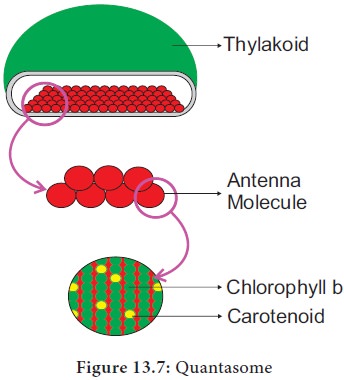Chapter: 11th Botany : Chapter 13 : Photosynthesis
Photosynthetic Unit (Quantasome)
Photosynthetic Unit (Quantasome)
Quantasomes
are the morphological expression of physiological photosynthetic units, located
on the inner membrane of thylakoid lamellae. Each quantasome measures about 180 Ă… Ă— 160 Ă… and 100 Ă… thickness. In 1952, Steinman observed granular structures in chloroplast lamellae under electron microscope. Later, Park and Biggins (1964) confirmed these granular structures as physiological
units of photosynthesis and coined the term Quantasome. According to them one
quantasome contains about 230 chlorophyll molecules. A minimum number of
chlorophyll and other accessory pigments act together in a photochemical
reaction to release one oxygen or to reduce one molecule of CO2. It
constitutes a photosynthetic unit. (Figure 13.7) Emerson and Arnold
(1932) based on flashing light experiment found 2500 chlorophyll molecules are
required to fix one molecule of CO2. However, the reduction or
fixation of one CO2 requires 10 quanta of light and so each unit
would contain 1/10 of 2500 i.e. 250 molecules. Usually 200 to 300 chlorophyll
molecules are considered as a physiological unit of photosynthesis. According
to Emerson 8 quanta of light are required for the release of one oxygen
molecule or reduction of one Carbon dioxide molecule. The quantum yield is 1/8
or 12 %.

Related Topics